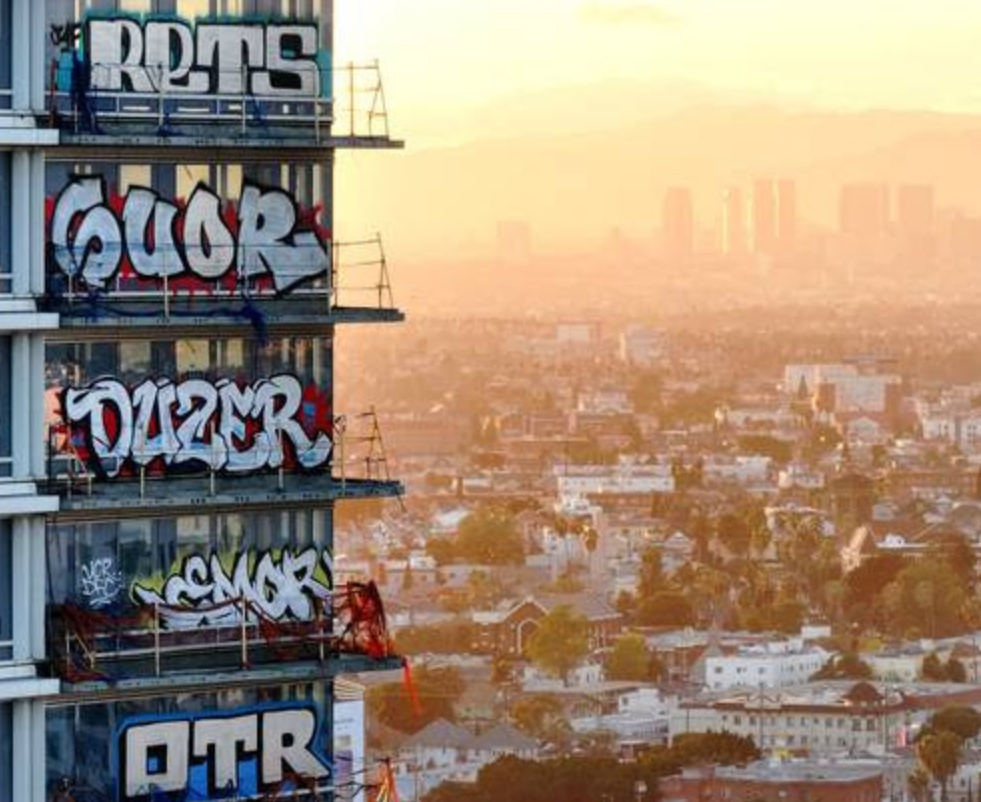The incident was not just an act of vandalism; it was a moment that raises profound questions about art, decay, and the meaning of public spaces. In this article, we explore the significance of this event, the cultural context of graffiti, and the broader implications for Los Angeles and beyond.
Oceanwide Plaza: A Monument to Ambition and Failure
Before its fall into stagnation, Oceanwide Plaza was envisioned as a gleaming symbol of luxury and ambition. Located in the heart of downtown Los Angeles, the $1 billion project was set to include high-end retail spaces, luxury condominiums, and a hotel. However, when the Chinese developer faced financial difficulties, construction abruptly stopped in 2019.
A Symbol of Economic Shifts
•The incomplete structure stands as a testament to the global flow of capital, particularly the rise and stall of Chinese investment in U.S. real estate.
•For locals, Oceanwide Plaza became a physical representation of unfulfilled promises, urban inequality, and the divide between aspiration and reality.
In its abandoned state, the project evolved into an eerie relic of halted progress—a prime target for graffiti artists looking to transform neglect into something meaningful.
Graffiti: Art, Rebellion, or Both?
The tagging of Oceanwide Plaza was not a random act of vandalism; it was an intentional reclamation of space. Graffiti has long existed at the intersection of art and rebellion, serving as a form of self-expression, protest, and community engagement.
The Dual Nature of Graffiti
•As Art:
Graffiti is a medium for creative expression, allowing artists to experiment with color, form, and messages in ways that often challenge traditional art spaces.
•As Rebellion:
By nature, graffiti defies authority, turning walls, buildings, and other structures into canvases that reject societal norms.
In the case of Oceanwide Plaza, graffiti artists used the building’s vast, empty surfaces to communicate not only their creativity but also a defiant commentary on the state of urban development, economic disparity, and the commodification of space.
The Power of Abandoned Spaces
Abandoned structures like Oceanwide Plaza often become powerful symbols of urban decay and neglect. These spaces invite a reimagining of their purpose, challenging conventional ideas about ownership and use.
Urban Decay as a Canvas
Aesthetic Potential:
The unfinished, weathered surfaces of abandoned buildings provide a raw, textured backdrop that enhances the visual impact of graffiti.
Symbolic Value:
Spaces like Oceanwide Plaza carry layers of meaning, from the failure of large-scale projects to the resilience of communities that adapt to their surroundings.
Graffiti as Reclamation
•The tagging of Oceanwide Plaza can be seen as a reclamation of space by those who are often excluded from decisions about urban development.
•By turning the building into a work of art, graffiti artists assert their presence in a landscape that prioritizes luxury over accessibility.
Graffiti and the Soul of Los Angeles
Los Angeles has a complex relationship with graffiti. As a city that thrives on creativity, LA has been both a haven for street artists and a battleground for debates about public art and property rights.
A Legacy of Street Art
•From the works of Chicano muralists in East LA to the global influence of artists like Banksy, Los Angeles has long been a hub for street art that reflects the city’s diverse cultural landscape.
•Graffiti in LA often serves as a voice for marginalized communities, addressing issues like gentrification, police brutality, and racial inequality.
Graffiti in Downtown LA
•Downtown Los Angeles, where Oceanwide Plaza is located, has undergone significant gentrification in recent years.
•The tagging of the building juxtaposes the glossy image of downtown’s redevelopment with the raw reality of its unfinished projects and economic divides.
The Meaning Behind the Graffiti at Oceanwide Plaza
The graffiti at Oceanwide Plaza is not just a collection of colorful tags; it’s a collective statement that can be interpreted in several ways:
A Protest Against Inequality
•The unfinished luxury development highlights the growing divide between the wealthy and the working class in LA.
•By tagging the building, artists may be critiquing a system that prioritizes high-end real estate over affordable housing and community resources.
A Celebration of Creativity
•The sheer scale of the tagging—27 floors—demonstrates the creativity, coordination, and ambition of the artists involved.
•In a city known for its art scene, the graffiti serves as a reminder that creativity often flourishes in unexpected places.
A Meditation on Decay
•The act of tagging an abandoned building can be seen as a commentary on impermanence and the cyclical nature of creation and destruction.
The Spectacle and Its Implications
The timing of the graffiti—just days before the Grammys—added a layer of spectacle to the event. Media coverage and social media posts amplified the visual impact of the tagging, drawing attention to both the building’s state and the art it now hosts.
Public Reaction
•Supporters: Many praised the graffiti as a bold artistic statement and a reclaiming of a failed project.
•Critics: Others viewed the tagging as vandalism that further deteriorates an already blighted area.
Legal and Ethical Questions
•The incident raises questions about the legality of graffiti and the ethical implications of transforming private property without permission.
•However, it also challenges traditional notions of ownership, asking: Who has the right to define how public and semi-public spaces are used?
Looking Ahead: What Happens Next?
The future of Oceanwide Plaza remains uncertain, but the graffiti has undoubtedly altered its narrative. Whether the building is eventually completed, demolished, or remains in limbo, the event highlights the power of art to transform how we view and interact with our surroundings.
For the Artists
•The graffiti may inspire other artists to seek out abandoned spaces as canvases for their work.
•It also underscores the need for more inclusive public art programs that provide legal avenues for creative expression.
For the City
•Los Angeles could use this incident as an opportunity to reflect on its approach to urban development, community engagement, and the role of art in public spaces.
Impression
The tagging of Oceanwide Plaza is more than an act of rebellion—it’s a powerful reminder of the intersection between art, community, and urban landscapes. In a city defined by its contrasts, the graffiti at this unfinished development captures the spirit of Los Angeles: a place where creativity thrives amidst chaos, and where abandoned structures can become symbols of hope, critique, and transformation.
As the dust settles and the paint dries, the incident at Oceanwide Plaza invites us to rethink the meaning of public art, the value of abandoned spaces, and the stories we tell about the cities we call home.
No comments yet.







